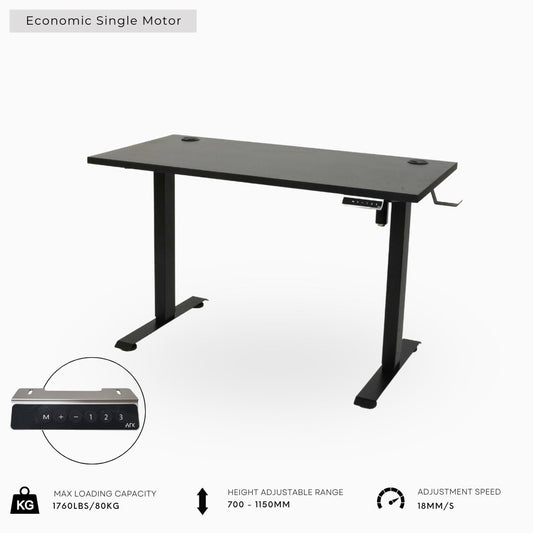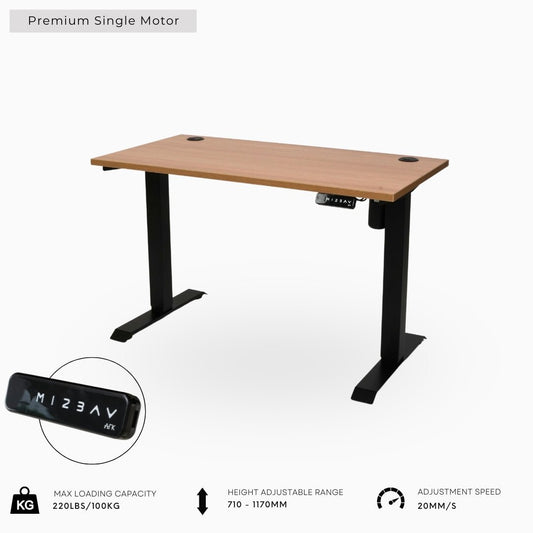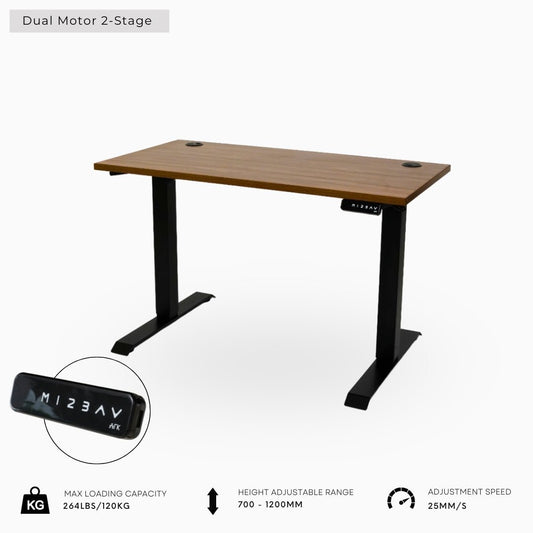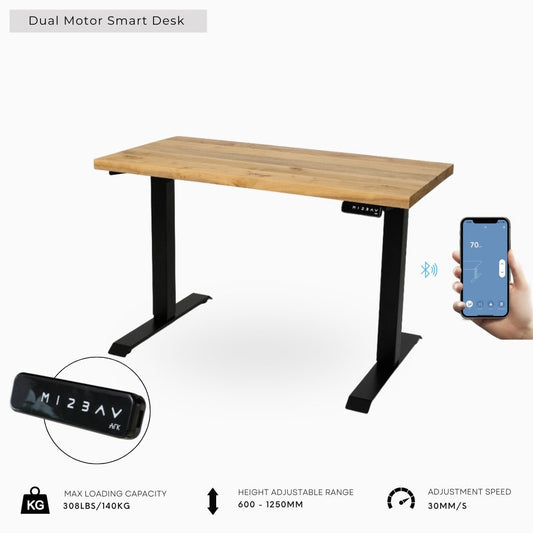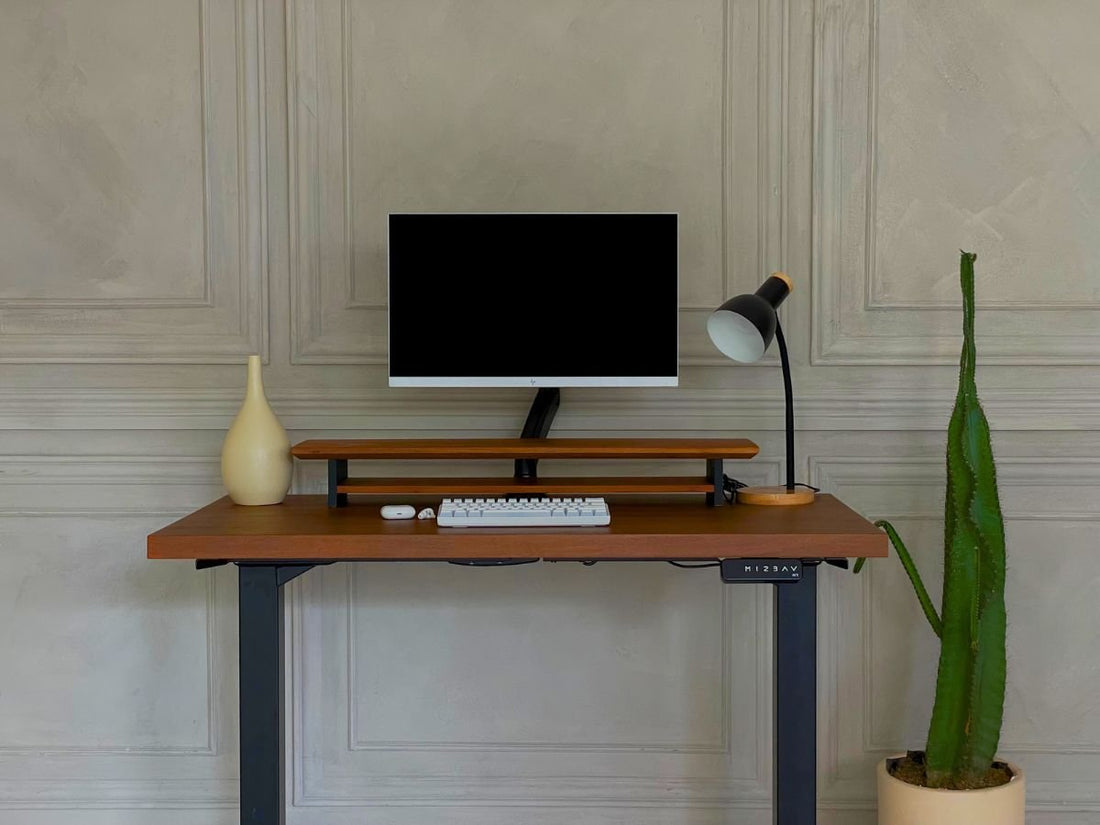
The Ultimate Guide to Standing Desks
Share
Welcome to a comprehensive resource dedicated to revolutionizing your workspace and well-being through the power of standing desks. Crafted for individuals aged 24 to 44 who are redefining their home offices, seeking relief from discomfort, or embarking on a transformative work style, this guide is your roadmap to making an informed standing desk choice.
Join us on this journey as we unlock the potential of standing desks and embrace a new way of working that elevates both your desk and your lifestyle. Welcome to the ultimate standing desk guide – your gateway to a more productive and healthier you.
Table of Contents
Section 1: Understanding Standing Desks
In today's fast-paced world, where most of us spend a significant portion of our day working at a desk, it's crucial to consider the impact of our workspace on our overall well-being. Enter the standing desk, a revolutionary solution that has gained immense popularity in recent years. In this section, we'll dive deep into the concept of standing desks, their health benefits, and the different types available to help you make an informed decision about incorporating this ergonomic wonder into your workspace.
1.1 What is a Standing Desk?
A standing desk, also known as a stand-up desk or sit-stand desk, is a versatile piece of furniture that allows you to alternate between sitting and standing while you work. Unlike traditional desks, which keep you confined to a seated position, standing desks offer the flexibility to adjust the desk's height to match your preference. This simple yet effective innovation is designed to reduce the negative effects of prolonged sitting, such as poor posture and a sedentary lifestyle.

1.2 What are the Health Benefits of Standing Desks?
The health benefits of using a standing desk extend far beyond just providing a change in posture. Research has shown that incorporating standing into your work routine can lead to a range of positive outcomes:
-
Improved Posture: Standing encourages a more upright and natural posture, reducing the strain on your spine and neck muscles.

-
Increased Energy Levels: Standing stimulates blood circulation and helps prevent the sluggishness often associated with prolonged sitting.

-
Reduced Risk of Chronic Diseases: Regular use of standing desks has been linked to a lower risk of obesity, type 2 diabetes, cardiovascular issues, and even certain types of cancer.

-
Enhanced Productivity: Many users report increased focus and productivity when using a standing desk, as it keeps them more engaged and alert.

1.3 What are the Different Types of Standing Desks?
Not all standing desks are created equal. Depending on your needs, space, and budget, you can choose from various types of standing desks:
-
Manual Standing Desks: These desks are adjusted manually using a crank or lever. They're typically more affordable and are a great entry point into the world of standing desks.

-
Electric Standing Desks: Electric desks offer effortless height adjustments at the touch of a button. They're convenient and allow for more precise customization.

-
Sit-Stand Converters: If you're not ready to replace your existing desk, a sit-stand converter can be placed on top of your current desk to transform it into a standing desk.

-
Treadmill Desks: For the ultimate active workspace, treadmill desks combine a standing desk with a treadmill, letting you walk while you work.

Each type has its advantages and considerations. The choice you make should align with your workspace, preferences, and how you plan to use the desk.
Section 2: What Factors Should You Consider Before Buying a Standing Desk?
Navigating the world of standing desks requires careful consideration of various factors to ensure your choice aligns seamlessly with your needs and preferences. This section explores essential aspects that will guide you towards selecting the perfect standing desk for your workspace and lifestyle.
2.1 Workspace Requirements
Begin your journey by evaluating the parameters of your workspace:
-
Available Space: Measure the area you intend to allocate for your standing desk. Ensure it provides ample room for movement and fits harmoniously within your workspace. Prioritize brands that are able to provide you multiple sizing options or customize specifically for your needs.
-
Existing Furniture: Consider how the new desk will complement your existing furniture arrangement. Harmony in design and functionality is key.
2.2 Adjustable Height Range
A central feature of any standing desk is its adjustable height mechanism. Look for a desk that offers a height range that suits your needs:
-
Sitting Height: Opt for a desk that allows your arms and shoulders to be relaxed. Your elbows should be close to your body and form an angle slightly greater than 90 degrees.
-
Standing Height: Opt for a desk that allows you to set your monitor at eye level and maintain a relaxed posture. This promotes comfort and reduces strain. Your standing height can be easily measured by bending your elbows at a 90 degree angle and measure the distance from the floor to your elbow.
2.3 Weight Capacity and Stability
Stability and longevity are paramount in a standing desk:
-
Weight Capacity: Select a desk with a weight capacity that accommodates your equipment and accessories. This ensures stability and prevents potential damage.
-
Stability: Wobbling is a challenge that most standing desk users face. Choose a desk that has a solid base and construction to minimize both side-to-side wobble and front-to-back wobble. Prioritize desks with dual crossbeam design, triangular wedge leg design, and horizontal crossbeam support design, which are known remedies to minimize wobble.
2.4 Ease of Adjustment
The convenience of altering your desk's height can significantly influence your work experience:
-
Manual Adjustment: Manual desks offer cost-effective adjustment through levers or cranks. However, they are not convenient to use and can influence your willingness to use the desks regularly in the long run.
-
Electric Adjustment: Electric desks provide effortless height changes with the press of a button, ensuring smooth transitions. Prioritize electric desks with save slots for automatic adjustments over those without as this can significantly improve ease of adjustment.
2.5 Warranty and Servicing
Account for warranty coverage and servicing:
-
Warranty: Research the warranty offered with the standing desk. A robust warranty reflects the manufacturer's confidence in their product's quality.
-
Servicing: Understand the manufacturer's policy on repairs and servicing. Prompt assistance ensures minimal disruption if issues arise.
2.6 Additional Features
Explore advanced features that enhance convenience and functionality:
-
USB Charging Ports: Some desks include USB ports, or even a wireless charging dock, enabling you to charge devices without cluttering your workspace.
-
Smart App Control: Certain models offer smart app integration, allowing you to customize desk height settings and receive posture reminders.
2.7 Budget Considerations
Strike a balance between quality and affordability:
-
Budget Range: Define your budget range and explore options that offer the best value within that spectrum.
As you assess these factors, remember that a standing desk is an investment in your well-being and productivity. By addressing each aspect thoughtfully, you'll be well-equipped to make a choice that elevates both your workspace and your overall work experience.
Section 3: How do You Choose the Right Standing Desk?
With a solid understanding of the key factors to consider, it's time to embark on the exciting journey of choosing the standing desk that best suits your needs and preferences. In this section, we'll walk you through the process of evaluating brands, models, and user reviews to make an informed and satisfying purchase decision.
3.1 Assessing Your Needs
Before delving into the vast array of options, it's crucial to pinpoint your specific requirements:
-
Work Activities: Consider your daily tasks—typing, drawing, writing, using multiple monitors, etc. Your desk should seamlessly support your work style.
-
Equipment: Take stock of the equipment you'll place on the desk—monitors, laptop, keyboard, mouse, etc. Ensure there's sufficient space and capacity.
3.2 Desk Styles and Designs
The aesthetic and design of your desk contribute to the overall ambiance of your workspace:
-
Aesthetic Preferences: Decide on a style that resonates with you—minimalist, modern, classic, or a blend of styles.
-
Finishes and Colors: Choose finishes and colors that harmonize with your existing décor and create a cohesive look. Brands offer plenty of variety on tabletop materials and colors. You can choose between a solid wood tabletop for added elegance or a regular laminated tabletop. Prioritize brands that are able to provide you a wide array of tabletop materials and finishes.
3.3 Brand and Model Research
Navigating reputable brands and models is essential to a successful purchase:
-
Reputation: Research brands known for quality, durability, and customer service. Consider brands with a strong track record in ergonomic furniture.
-
Model Selection: Within each brand, explore various models. Look for features that align with your needs, such as height range and additional features.
3.4 User Reviews and Testimonials
Harness the power of user experiences to refine your choice:
-
User Reviews: Explore online reviews to gain insights from real users. Consider both positive and negative feedback to form a balanced perspective.
-
Testimonials: Seek testimonials from friends or colleagues who already use standing desks. Their experiences can provide valuable insights.
3.5 Making the Decision
Armed with information and insights, it's time to finalize your decision:
-
Comparison: Create a comparison chart that includes key specifications, prices, and features of shortlisted desks. This will provide a visual aid for decision-making.
-
Value Proposition: Consider not only the cost but also the long-term value the desk offers in terms of health benefits, productivity gains, and comfort.
3.6 Budget and Investment
Remember that your standing desk is an investment:
-
Balancing Quality and Budget: Strive to strike a balance between your desired features and your budget constraints. The most affordable model today is not always the best option nor is it the cheapest in the long run, if you take into account quality, warranty, and servicing.
-
How much does a standing desk cost in the Philippines?: Standing desks in the Philippines typically costs between Php 12,000 for economic models to as high as Php 50,000 for executive L-shape solid wood standing desk workstations. The price of a standing desk increases as the quality of electric components and structure design increases.
3.7 Embrace Your Choice
Once you've made your selection, embrace your new standing desk:
-
Personalization: Customize your workspace with ergonomic accessories, storage solutions, and personal touches.
-
Adaptation: Ease into your new routine gradually, allowing your body to adjust to the standing position over time.
Selecting the right standing desk is a process that blends practical considerations with personal preferences. By meticulously assessing your needs, researching brands and models, and incorporating user insights, you're setting the stage for a workspace that elevates both your productivity and well-being.
Section 4: How do You Set Up Your Standing Desk Workspace?
Congratulations on selecting the perfect standing desk that aligns with your needs and preferences. Now, it's time to transform your workspace into an ergonomic haven that fosters productivity, comfort, and well-being. In this section, we'll guide you through the process of setting up your standing desk workspace for optimal functionality and posture support.
4.1 Workspace Ergonomics
Creating an ergonomic workspace is pivotal for long-term comfort and health:
-
Desk Height: Set the desk height to allow your elbows to rest at a 90-degree angle when typing. Your wrists should remain straight and in line with your forearms.
-
Monitor Position: Position your monitor at eye level, about an arm's length away. Adjust the tilt to prevent neck strain.
-
Keyboard and Mouse: Keep your keyboard and mouse at the same level to maintain a neutral wrist position.
4.2 Transitioning to a Standing Routine
Transitioning to a standing work routine requires a gradual approach:
-
Alternate Intervals: Begin by standing for short intervals, gradually increasing the time. Listen to your body and sit when needed.
-
Anti-Fatigue Mat: Consider using an anti-fatigue mat to cushion your feet and reduce strain during prolonged standing.
4.3 Personalizing Your Workspace
Add a personal touch to your standing desk workspace:
-
Plants: Incorporate indoor plants to enhance air quality and create a calming atmosphere.
-
Proper Lighting: Ensure adequate lighting to prevent eye strain. Position your desk near a natural light source if possible.
-
Storage Solutions: Organize your workspace with storage solutions that keep essential items within arm's reach.
4.4 Movement and Breaks
Remember that movement is key to a healthy work routine:
-
Microbreaks: Take short breaks every 30 minutes to stretch and move around. This prevents stiffness and promotes blood circulation.
-
Stretching Exercises: Integrate simple stretching exercises to relieve tension in your neck, shoulders, and back.
4.5 Listening to Your Body
Pay attention to your body's cues:
-
Comfort: If you experience discomfort or fatigue, adjust your posture or switch between sitting and standing.
-
Footwear: Wear supportive footwear that cushions your feet during standing periods.
4.6 Productivity and Wellness Harmony
Strive for a balance between productivity and wellness:
-
Task Allocation: Assign different tasks to sitting and standing periods. Standing might be ideal for brainstorming and reading, while sitting suits focused work.
-
Mindful Posture: Continuously monitor your posture to ensure you're maintaining a neutral spine and relaxed shoulders.
Section 5: How do You Maintain and Care for Your Standing Desk?
Congratulations on your commitment to an ergonomic and productive workspace with your standing desk. To ensure its longevity and continued effectiveness, it's essential to provide proper maintenance and care. In this section, we'll guide you through the steps to keep your standing desk in excellent working condition.
5.1 Cleaning and Maintenance
Regular cleaning and maintenance will keep your standing desk functioning smoothly:
-
Dust and Debris: Wipe down the surface of the desk regularly to remove dust and debris. Use a soft cloth or microfiber towel to prevent scratching.
-
Mechanisms: Inspect the adjustment mechanisms for any debris or obstructions that could hinder movement. Clear any dirt gently.
-
Cleaning Solutions: Use gentle cleaning solutions to avoid damaging the desk's finish. Avoid abrasive cleaners that can scratch the surface.
5.2 Maintaining Electrical Components
If you have an electric standing desk, additional care is needed for its electrical components:
-
Cable Management: Organize and secure cables to prevent tangling or damage to electrical components.
-
Electrical Outlets: Ensure your desk's electrical components are safely connected to power sources and not exposed to moisture.
5.3 Seeking Professional Servicing
If you encounter any issues beyond your expertise, it's wise to seek professional help:
-
Warranty: If your desk is under warranty, contact the manufacturer for repairs. Avoid attempting DIY fixes that could void the warranty.
-
Certified Technicians: If you're beyond the warranty period, engage certified technicians to diagnose and fix the issue.

